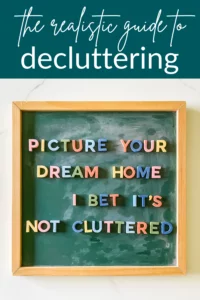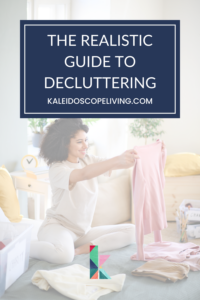Learn How to Declutter Your Home: A Realistic Guide
Are you tired of wasting precious time shuffling papers and looking for your missing shoe, or your vanishing purse? Do you dream of doing what it takes to declutter your life, but never take action because you are too busy and too tired? After all, between work and taking care of your kids or family, you barely have enough time to sleep?!
By reading this post, you will learn how to declutter your home the realistic way. Decluttering your home won't happen overnight, but with this realistic approach, you can start making progress right away with as little as 10 minutes!
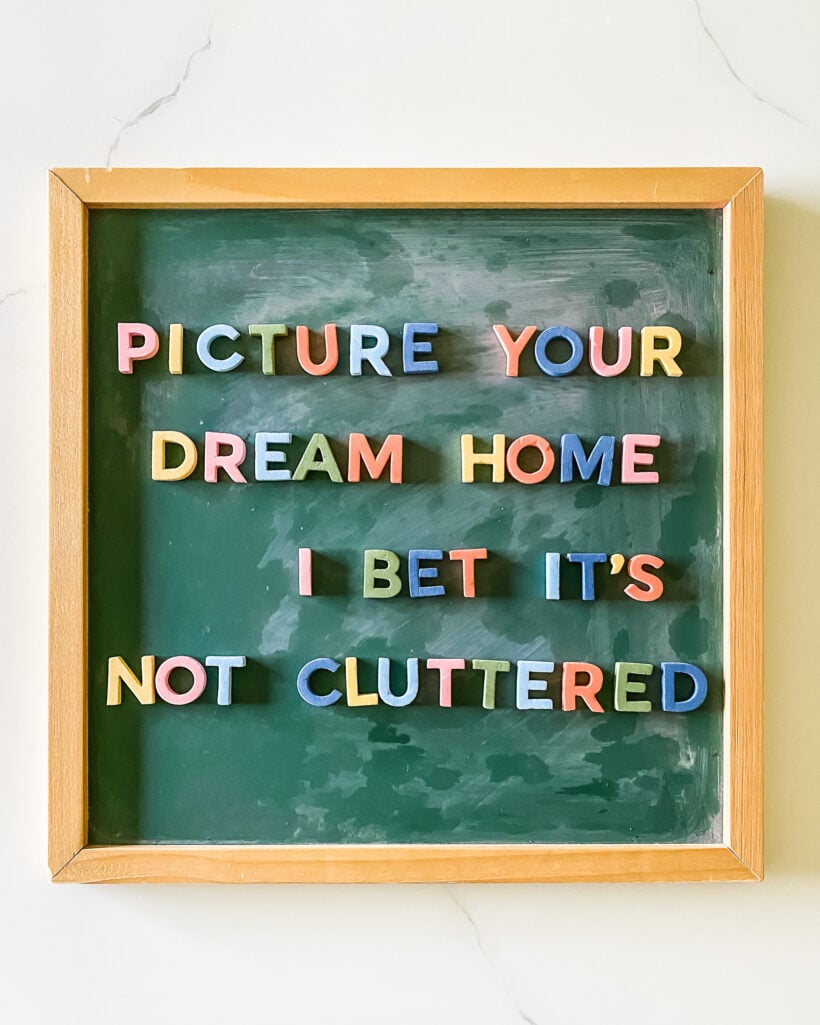
You’ve got great reasons for wanting to have less clutter and be more organized. You want the best for your family. You want to teach your kids to live in calmness, not chaos. You want to be patient without losing your ever-lovin’ mind in the insanity of so much stuff. And you just want to savor the time you have, instead of running around chasing clutter. But sometimes it just feels so hard. And you don't have days on end to dedicate to decluttering.
Trust me. You are not alone. Let's talk about why you really NEED to declutter your life and how to do it!
This post is very thorough, so it's long. Be sure to subscribe to download my declutter your home checklist–it's the ultimate 1-page cheat sheet for everything I share in this post. And it's PERFECT to print out and so you have a quick reminder of how to declutter any space in your home.
Before we get into specific steps and tips for how to declutter your home, there are some things that we need to talk about first. Because if you try to declutter your home without understanding why it's so important, your decluttering efforts won't be nearly as effective.
What is clutter?
Clutter can be defined in lots of different ways. The dictionary definition of clutter is “a collection of things lying about in an untidy mass.” But I think a more accurate definition of clutter is anything you have that you don't love or use. In other words, if a thing or object doesn't add value to your life, it is clutter. If you keep a lot of things you don't love or use, check out these 10 tips to tame your inner hoarder.
What is decluttering?
Decluttering is the process of getting rid of those things that don't add value to your life in order to make room in your home for the things that truly matter.
Why is Clutter a BIG Problem?
Clutter is ugly
There, I said it. Clutter just looks bad. As someone who primarily shares interior design tips and DIY home projects, I have said it a zillion times… A cluttered room will never be a beautiful room. So many people make the mistake of trying to come up with a cohesive design plan for a room before they declutter their mess.
And they wind up trying to decorate around their clutter. You can guess how poorly that goes. They spend time and money bringing in new throw pillows or they add a colorful rug that they love to the room hoping the changes will make them fall in love with their space. But the clutter is still there and it is dragging down the entire room.
Clutter affects your stress
It's a fact that clutter increases your stress levels. According to UCLA's Center of Everyday Lives and Families, there is a link between the stress hormone cortisol in women with cluttered homes. Not only that, but A Princeton University Neuroscience Institute study found that people in cluttered homes experience greater exhaustion. Why? Because clutter requires you to expend more mental energy. Quite simply, clutter makes it harder to focus and process information, so it requires more energy to complete ordinary, everyday tasks.
Clutter hurts your wallet
Clutter results in you wasting money. When you have piles of unopened mail there is a good chance that you are going to pay some late fees on bills that could have been avoided. And if you have a cluttered pantry where you can't see everything, a closet that's so full you can't remember what's in it, you are almost certainly going to purchase duplicates, which is a total waste of money (AND it makes your clutter problem even worse).
Clutter wastes your time
Clutter and disorganization wastes time. If you've been around a while you know how passionate I am about keeping our family schedules and lists organized. How many minutes/hours have you wasted looking for your phone, or your shoe, or your kid's soccer cleats? How many times have you been late for a meeting or dinner with friends because you couldn't find something to wear in your messy closet?
Crucial Tips Before You Start Decluttering Your Home
Before we get into the room-by-room decluttering tips, there are some really, really, really important tips that we need to cover first.
Don't Let Emotions Win the Decluttering Battle
Believe me when I tell you I used to struggle with letting things go. I wrestled with the emotions that so many of us do when we try to declutter. You know what I'm talking about… “But this was a gift–I don't want to see ungrateful,” OR “I love that coat so much and it might fit me again one day,” OR “I can't just get rid of this, it was so expensive!” The struggle is real. But to be successful, you have to conquer the emotions of decluttering. Take some time to decide once and for all that you will not let your emotions get in the way of parting with items that are NOT serving you or bringing you any joy.
Don't Wait Until You “Have Time”
Is this the opposite of what you thought I would say? A lot of people recommend that you set a timeline and pick a time on your schedule to declutter. I do NOT recommend this. Here's the thing… Decluttering is an ongoing process. It literally never ends. I declutter regularly. And you have to if you want to live in a truly decluttered home. I'm not saying that to be discouraging. The opposite in fact–once you understand that decluttering isn't a task with a clear beginning, middle and end, you will think about it differently which will actually HELP you!
So instead of setting a deadline or schedule, JUST START. Set a timer for 10 minutes if that's all you have. Your only goal should be to make PROGRESS. If you set a goal of “done” you will never meet it and you will keep putting it off until you “have time” (which you think means days or weeks) to declutter your entire home. That is simply not how decluttering works. Do what you can, when you can. It may take you weeks of working in 10-minute bursts to declutter your entryway. That is not only fine, that is NORMAL.
That said, I do recommend is sticking to one area at a time until you finish it. If you bounce around from room-to-room, you will not make significant progress, which will kill your motivation.
Start With a Highly Visible Area
This is a tip I learned from the brilliant Dana K. White of A Slob Comes Clean. I read her most recent book (which I highly recommend) when I was preparing to interview her for the 2022 Beautiful Home Beautiful Life Summit. When I read it in her amazing book it was such an “aha moment” that I had honestly never thought about. Dana says,
“I learned the hard way that decluttering momentum is best achieved by following the Visibility Rule. Tackling a rarely used drawer in the garage feels so right, but it's wrong… Start decluttering in the most visible area. I recommend starting at your front door, or whichever door guests enter.”
– Dana K. White, Decluttering for the Rest of Us
It seems so obvious now that you've read that quote, doesn't it?! But the fact is, many of us are tempted to start in a rarely used closet or an overstuffed attic. Don't do that! Start with the most visible areas in your home so you can really see your process and appreciate it.
The Ground Rules
If you don't decide on RULES for deciding what stays and what goes at the outset, you will lose the battle with clutter. Here are the rules I follow when I declutter a space.
- It must have a home. If it doesn’t have somewhere to go, it doesn’t stay. Period. And a pile on top of your kitchen counter or dining room table does not count as a home. It must be a permanent home.
- It must have a CURRENT purpose or be something you love. Stop holding on to something just because it was a gift, or because “you may need it” someday. Get rid of those items such as clothes and decor that you feel “meh” about. Hanging on to all of those things actually creates more work for you and weighs you down. Getting rid of it makes room for things that are useful and that you truly love!
- When you decide to get rid of something, get it out of your house QUICKLY. If you put it in a box to donate and it winds up sitting in your garage for 6 months, you haven’t really decluttered–you have just moved the clutter. I recommend planning to make routine trips to your favorite charity as you work your way through this guide. If you set aside things to sell on Ebay, Facebook Marketplace or in a garage sale (both of which I will discuss toward the end of the guide), you can give yourself a bit longer to turn them around, but set a deadline for selling the items. If they aren’t sold by that date, donate them or throw them away.
Decide How to Handle Your Paper Problem
Do you often feel like you are drowning in PAPER? OMG, I used to feel that way all the time. Just the amount of paper my twin girls brought home from school every day was enough make my head spin. Add in all the mail, receipts, insurance documents, etc. and the piles just kept growing. Fortunately, my husband and I decided several years ago to work towards going paperless and IT IS A HUGE HELP. We aren't totally paperless, but we are no longer overwhelmed by the amount of paper coming in and we don't have random stacks of paper to deal with anymore.
Going paperless isn't hard, but you do need to learn some new tools that you have probably never used in order to do it quickly and easily (that was certainly true for me).
That's why I highly recommend that you check out an incredible course that my sweet friends Donnie and Abby Lawson created called Paperless Made Simple. Donnie and Abby have maintained a paperless home for over a decade now and have used a tried and true system to make it happen with a simple tool called Evernote.
Paperless Made Simple is a practical, step-by-step course that walks through the essential theory, technical details, and practical workflow of creating and utilizing your digital filing cabinet. Integrating their simple paperless workflow into your daily routine will be a total game changer, eliminating paper clutter without taking much extra time out of your day at all. Once you have the workflow down, being paperless will be second nature– you’ll do it without even thinking about it!
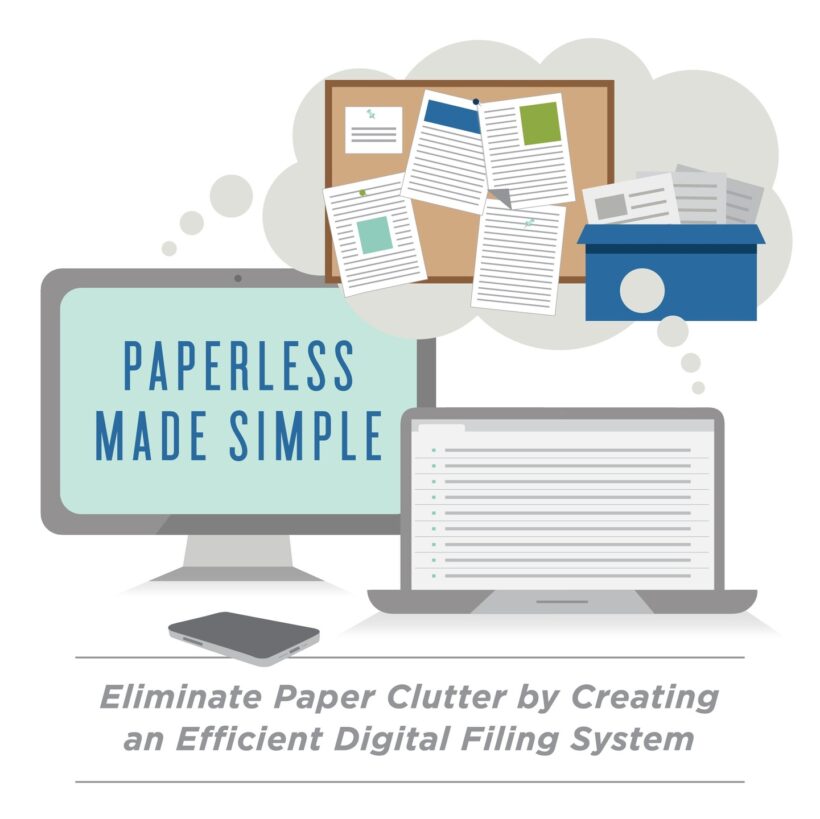
The Basic Steps for Decluttering Any Space In Your Home
The First Two Steps of the Decluttering Process for Every Room and Space In Your Home
✓ Do a quick sweep of the room to remove and put away any items that clearly belong in other rooms. Use a basket to collect items that belong in other rooms and return them to their proper homes. Don't spend too much time on this step–this should be a quick, easy pass-through where you aren't really making any decisions. You are just returning your kids' clothes to their bedrooms, books to bookshelves, etc.
✓ Clear all paper and put it with all other paper that needs to be handled so it can be done at the same time. Hopefully, you have decided to go paperless and will solve the issue once and for all :)
After you have done those two quick “first steps” for a space, now you are ready to start sorting.
Create a Sorting System
I personally recommend the popular Three-Box Method, but I modify it slightly into the “Three-Box + a Trash Bag Method.” This method helps prevent you making a bigger mess in the process of decluttering. All you need to do it get 3 cardboard boxes and label them “keep,” “donate” and “sell.” You could combine your donation and sell items, but I don't recommend it since the items you donate should get out of your house ASAP and those that you designate to sell may have to hang around a bit longer.
I don't want this post to get redundant, so here are the steps that you will complete for every single room in your home that you want to declutter. If there are special considerations for specific rooms/spaces, I will go into those a bit later :)
Throw Away Anything That's Broken, Expired or Missing Pieces
This is somewhat self-explanatory, but many people struggle with throwing stuff away. If something is broken or missing pieces, put it in your trash bag immediately. Don't try to convince yourself it can be fixed or that you will find the missing pieces. Just make your peace with it and throw it away. Ditto for something that has an expiration date that has passed.
Decide Whether to Keep, Sell or Donate What's Left
Remember, the ground rules we covered above. Here's a quick recap:
- In order to keep something, it must have a permanent home. It must have a current purpose OR it must be something YOU absolutely LOVE.
- If you decide to donate something, get it out of your house quickly.
- If you decide to sell something, set a deadline. If it hasn't sold by then, donate it or throw it away.
Be Realistic About What You Can and Should Sell
If you come across an item that you think “that's worth something! I should sell it” I need you to be brutally honest with yourself and ask the following questions…
1) Is it there a market for the item?
We had an old, rear projector TV that we needed to get rid of. It was a NICE and relatively expensive TV when we purchased it, but there was NOT a market for it because flat-screen TVs are so affordable these days (and you can display art on any smart TV and update it to look like a super expensive Frame TV). In fact, most charity organizations won't even accept old TVs anymore! It doesn't matter how much you paid for it when you bought it or how nice it is. All that matters is whether there is a current market for it. If there isn't, don't put it in your sell pile.
On the other hand, a few years ago we sold a large Pottery Barn sectional sofa that was in fantastic shape even after 10 years of use and we sold it for nearly $900 because there was a solid market for it.
If you are in doubt about whether there is a good market for your item, browse Craigslist, Ebay and even online Facebook groups to get a sense for whether similar items are selling.
2) Is it worth my time to sell it?
It takes time to list something on Craigslist, Facebook, or Ebay. And it takes even more time to communicate with potential buyers, arrange pickup, etc. So, it’s probably not going to be worth your valuable time to sell something for $5 or $10. The only exception to this is tagging multiple clothing items for a consignment sale–each piece may only sell for $5 or $10, but it can be worth the cumulative amount if you pick the right consignment sales.

If you ask yourself these two questions and the answer to one or both is “no,” then you are probably better off donating it. I know it can be hard to feel like you have lost money, but sometimes it really is best just to let your stuff go. It will feel so good to get it out of your home and remember, someone else may really need it and love it, which feels good as well!
How to Declutter Your Home Room-by-Room
Now that you know the basic steps of how to declutter your home and know steps to follow for every space in your home, you can get started. But of course there are some more specific guidelines and tips for how to declutter certain areas of your home. If I go through every single room, this would turn into a book. So I'm just going to hit on the rooms that people seem to struggle with the most.
Decluttering Your Kitchen
Kitchens are one of the hardest rooms in the house to keep a handle on, and kitchen countertop storage and organization can be particularly challenging. But it's SO important to keep your kitchen functional and tidy because the kitchen is where we gather to do SO MANY things. It is certainly the heart of our home! It is where the cooking, homework, arriving and leaving, eating, and chatting happens. That is a lot for one room!
Countertops
The trouble with kitchen counters is that they are often the largest flat surface in our home. As a result, a WHOLE lot of things end up on kitchen counters that shouldn’t be there. Books, mail, magazines, school papers, appliances, groceries, etc. The problem is that having cluttered countertops REALLY hinders the function and enjoyment of your kitchen. And frankly, I don't want to cover up my beautiful countertops that I painted to look like marble, lol!
The key to keeping your kitchen counters clear of all but the essentials is to establish a clear no-clutter policy that is strictly enforced. When you establish a family command center and work your way to going paperless, keeping your kitchen counters clear will be much easier than it seems now. If you don't know what I am talking about, check out Why Your Busy Family Needs a Command Center.
✓ Clear all paper from your kitchen counters. I know I mentioned this in the “steps for every room” section, but it bears repeating here because if you are like most people, you end up with a piles of paper on your kitchen counters.
✓ Keep only absolute necessities out on your counters. For my family, that includes a coffee maker and toaster, because we use those items daily. We also have a a jar with olive oil in it and salt and pepper (by the stove) and dish soap by the sink. That’s it! If you can scale it down to even less than that, go for it. A clean, clutter-free kitchen can go a long way in reducing your stress and making meal prep time way more enjoyable. It’s also much easier to unpack groceries when your counters aren’t cluttered by paper and other stuff.
✓ If you have a tiny kitchen, you need to make some hard choices. Is your kitchen tiny with little cabinet space? I GET IT. Truly, I do. Most of my former houses had small kitchens with limited storage (so I've had to come up with many clever DIY storage solutions for small spaces). The struggle is real! It can be easy to feel like you HAVE to keep things out on your kitchen counters. But, there are some creative solutions that will help you. Be sure to check out my post on genius storage ideas for small kitchens and learn how to maximize every inch of storage space that you have.

Cabinets & Drawers
Kitchen cabinets and drawers are PRIME real estate that need to be used well to have a kitchen that functions well. When we moved into our current home, we not only painted our kitchen cabinets, but we invested time and money into decluttering them and making them function a lot better for our family.
And cabinets and drawers that are crammed full are not ideal. I can't cover all of my thoughts about decluttering and organizing kitchen cabinets and drawers here, so be sure to check out my detailed post on how to organize kitchen cabinets and my post full of inspiring kitchen cabinet organization ideas.
But here are some of my tips for using your kitchen cabinets and drawers to their full potential.
✓ Get rid of duplicate utensils. You don't need two vegetable peelers, 5 spatulas, and 3 hand whisks. You just don't. Getting rid of unnecessary duplicates will free up a lot of valuable space for things that you use on a daily basis.
✓ Reduce the number of pots and pans you have. Most people have far more than they actually use and they take up a ton of space.
✓ If you can't remember using it in the past 12 months, you probably don't need it so get rid of it.
✓ Evaluate your food storage. Most people have WAY more containers for leftovers, etc. than they need. Get rid of extras. And PLEASE get rid of any container that is missing a lid :)
✓ Move rarely used items somewhere else. You don't need to store your holiday dishes in your kitchen. Free up that space by moving them somewhere else. I store ours in the console table in our entryway. You could even put them in dish storage bags and slide them under a bed.
✓ Make sure the items you use every single day are the easiest things to reach (in front and on lower shelves).
✓ Group like items with like items. Try to store all baking items together, all pots and pans together, all food storage items together, etc.
You can see some of these concepts in place in our kitchen. And you can scroll below to see some of the products we added to our own cabinets and drawers to make them function a lot better.
Scroll and click on any image below for full product details

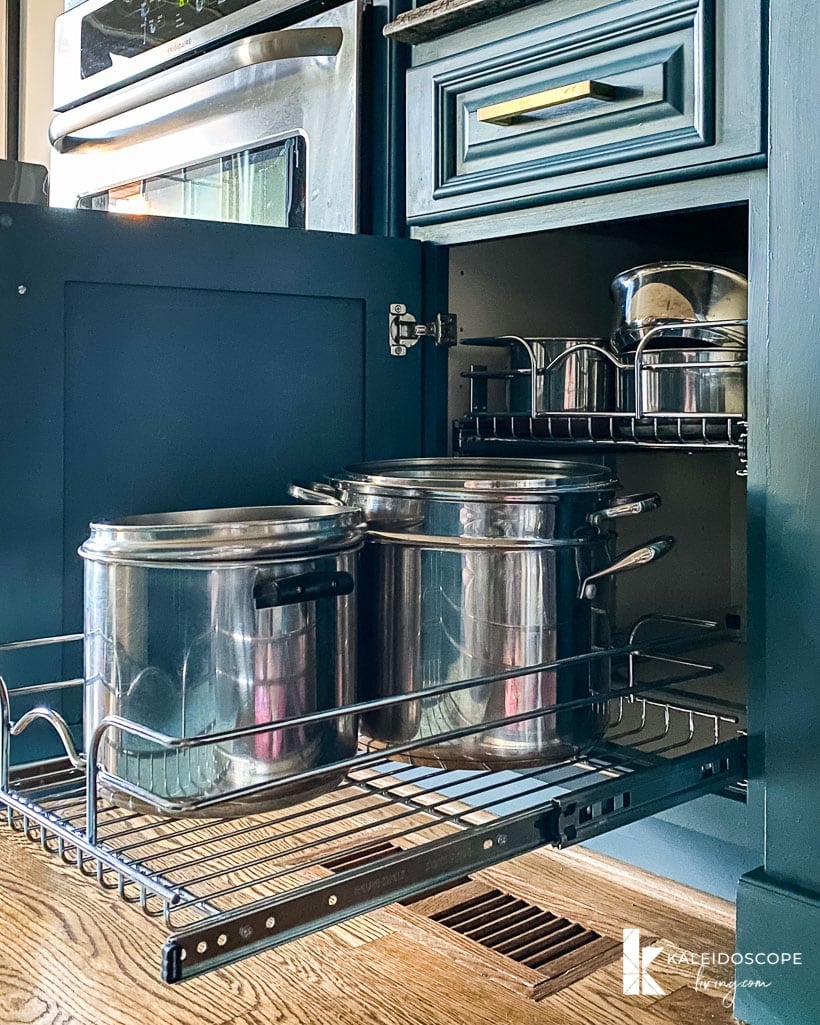
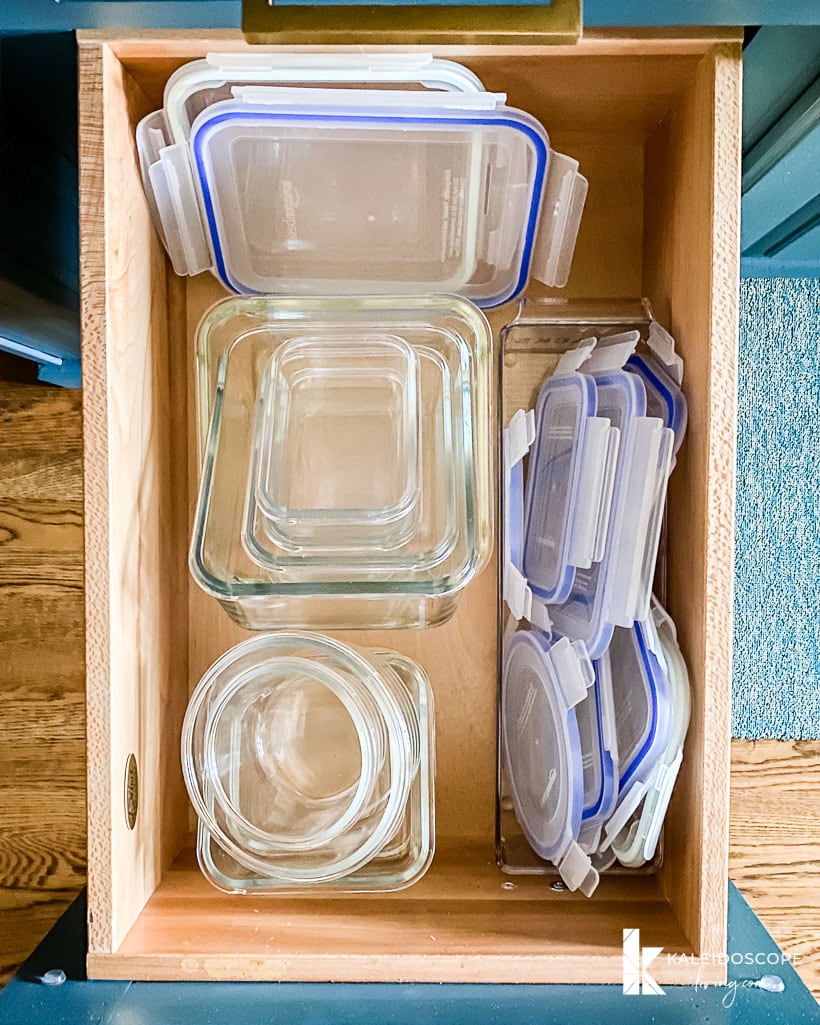
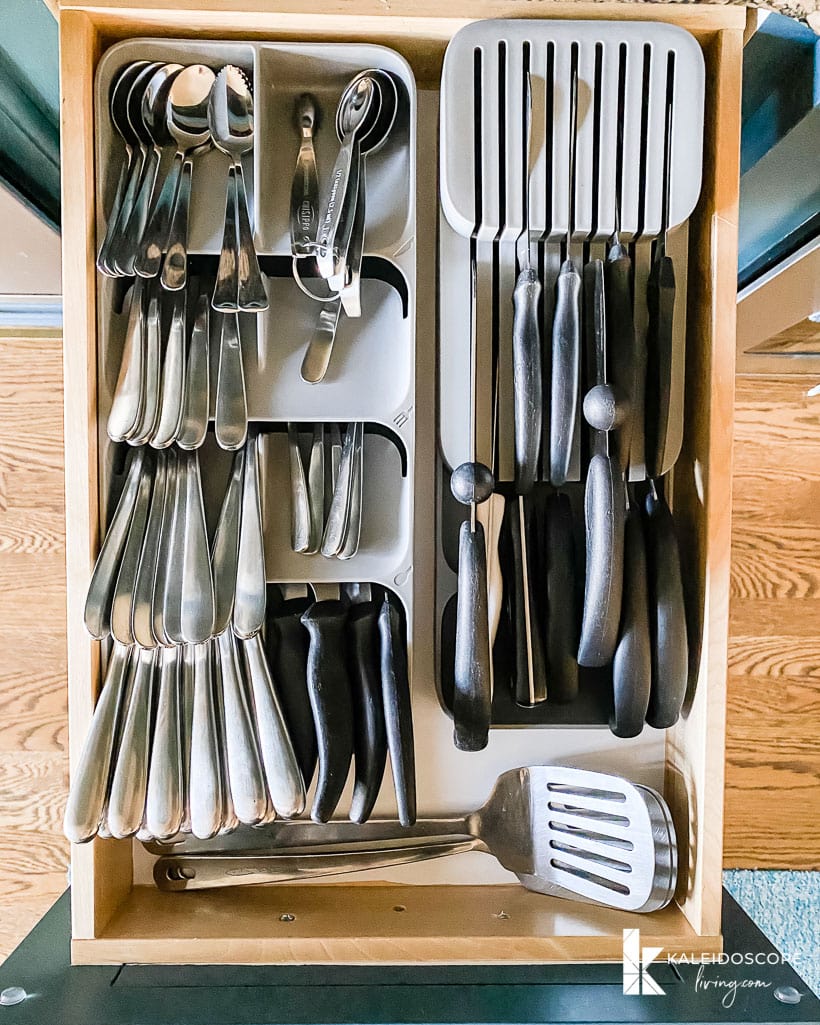
Decluttering Your Bathroom(s)
Other than the kitchen, I think bathrooms are the most common rooms in a house to accumulate lots of clutter (excluding the attic and garage, of course). There’s something about cosmetics, shampoo, makeup, toothpaste, samples from the dentist, travel bottles, etc. that can lead to a GIANT MESS. Fortunately, I also find that bathrooms are one of the easiest and quickest rooms to declutter.
✓ Get rid of old towels and wash cloths that you don't use anymore. Towels take up a surprising amount of space and I'm always amazed by how many extras people hang on to but never use. If you want to keep them as cleaning rags, etc. fine, but move them out of your bathroom to somewhere they will actually get used for that purpose.
✓ Clear and declutter all flat surfaces. Remove as much from your bathroom counter as possible. Keep only the absolute necessities on your counter on a daily basis. After you declutter your drawers and cabinets, you should be able to find some room to store some of what was on your counters.
✓ Sort and declutter each drawer, medicine cabinet and other cabinet, one at a time. Get your trash bags ready! If your bathroom is anything like mine was, you are going to be throwing A LOT of stuff away. Follow these tips as you go through each cabinet and drawer:
- If you hate it, throw it away. Have you ever purchased a shampoo that does horrible things to your hair, but instead of throwing it away, you stash it away in a cabinet? I have! Now is the time to trash it, or perhaps donate it to a shelter. Just get rid of it!
- If it has expired, throw it away. Many toiletries and cosmetics have expiration dates on them. ALL medicines, even over-the-counter medications, have expiration dates on them. LOOK AT THE DATES! If the date has passed, it goes in the trash. PERIOD.
- Makeup can hang on to loads of bacteria, so it’s important to know how long to keep it. For makeup that doesn’t have an expiration date on it, follow these guidelines:
- Generally speaking, eye makeup (including mascara, eyeliner and eyeshadows) should be tossed after 3 to 4 months. The reason for this is that your eyes have sensitive mucous membranes around them that can become irritated if you are using products that are full of bacteria. Worst case scenario is that you get an eye infection as a result, which is no good!
- Foundations and liquid concealers should be tossed 6-12 months after opening. Stick concealers, on the other hand, can be kept for up to 2 years before needing replacement.
- Powder-based products, such as powders, bronzers and blush, can generally be kept for up to 2 years! As noted above, powder based eyeshadows are the exception to this rule and should be discarded after only 3 to 4 months.
- Lip gloss should be tossed after 6 months, but you can hang on to lipstick for up to a year.
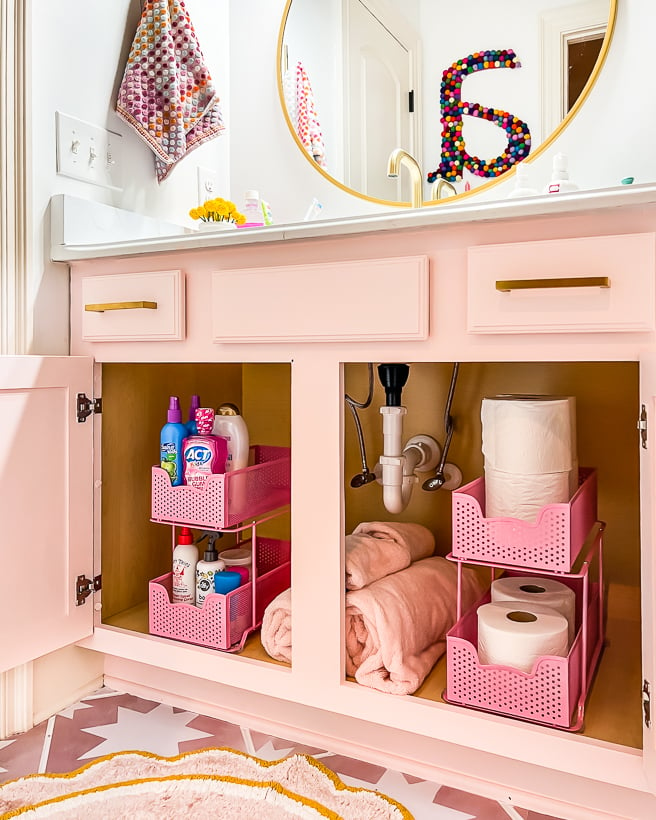

Decluttering Your Living Room
If the kitchen is the heart of the house, then the living room is the soul. It is where families gather to do all the things–watch TV, kids play and parents work, and even eat (don't tell my kids, LOL). But do you find it difficult to relax in your living room because there are constantly items out of place or it’s full of toys and other clutter? It is SO easy for this room to get become a hod podge because it has so many uses. These tips will help you create an organized living room that will allow you to relax and enjoy the space.
✓ Get rid of anything that is simply too big for the room and/or is constantly in your way.
✓ Cords technically aren't clutter if they are being used. But they certainly LOOK like clutter. So take the time to tame your cords and cables. In my opinion, even the most beautiful and organized rooms can be visually ruined by untamed cords. In our current family room, I bought a pretty basket to keep our router and other devices in. It looks so much better than having a pile of stuff sitting on the floor behind our sofa. You can spy it back there by our floor lamp–you would never know the big mess that lives inside of it, lol.
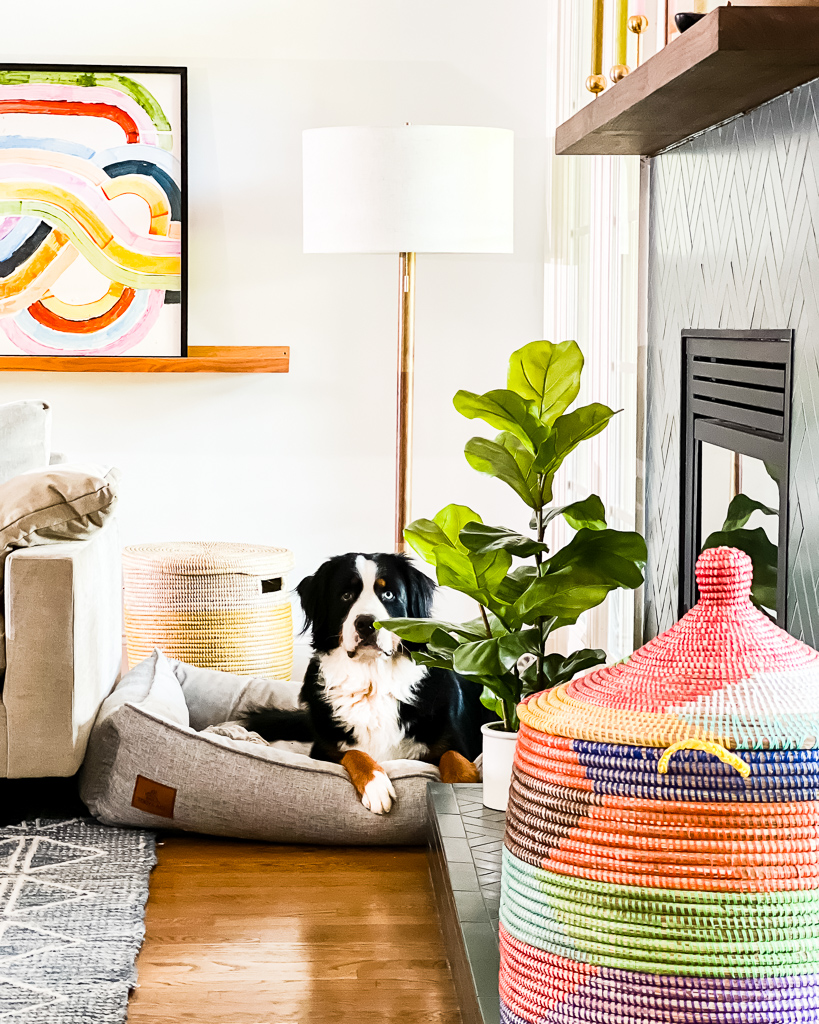
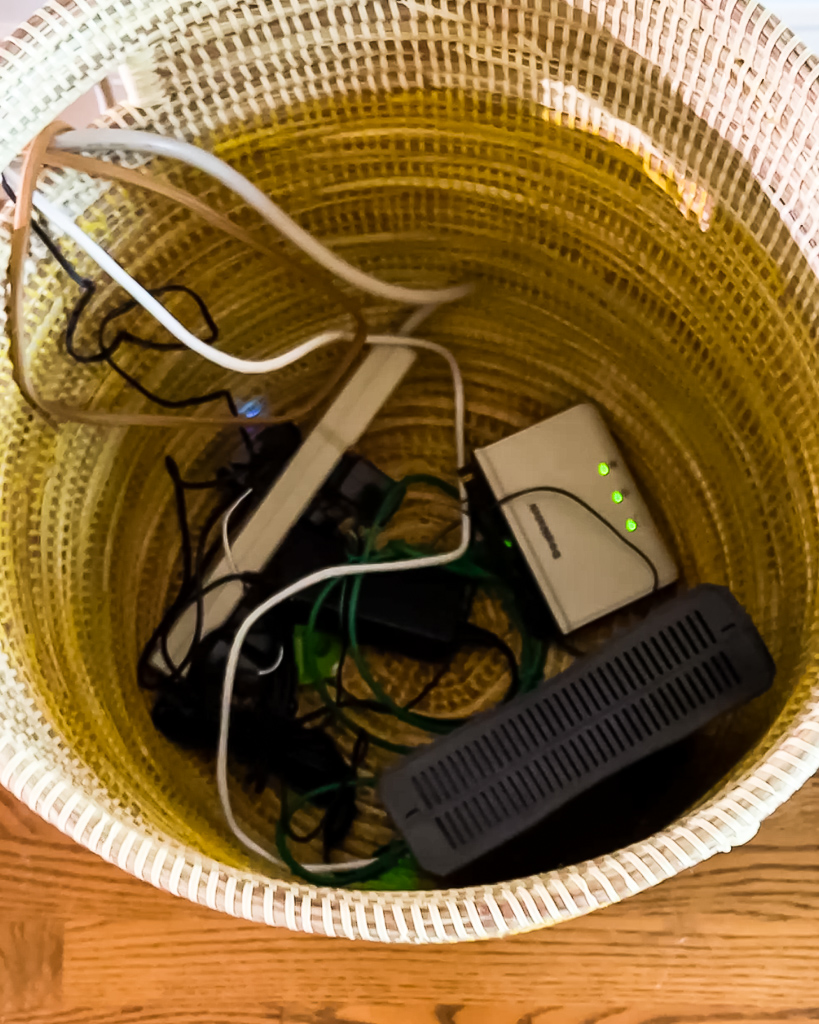
Below are some great options for cord management.
Scroll and click on any image below for full product details
✓ If you have kids, but don't have a designated “playroom,” create a dedicated toy zone. In our old house we used a corner of our family room to store a lot of their toys, board games, etc. If your living room has to serve double-duty like ours did, practical and pretty room organization solutions will be super important to you.

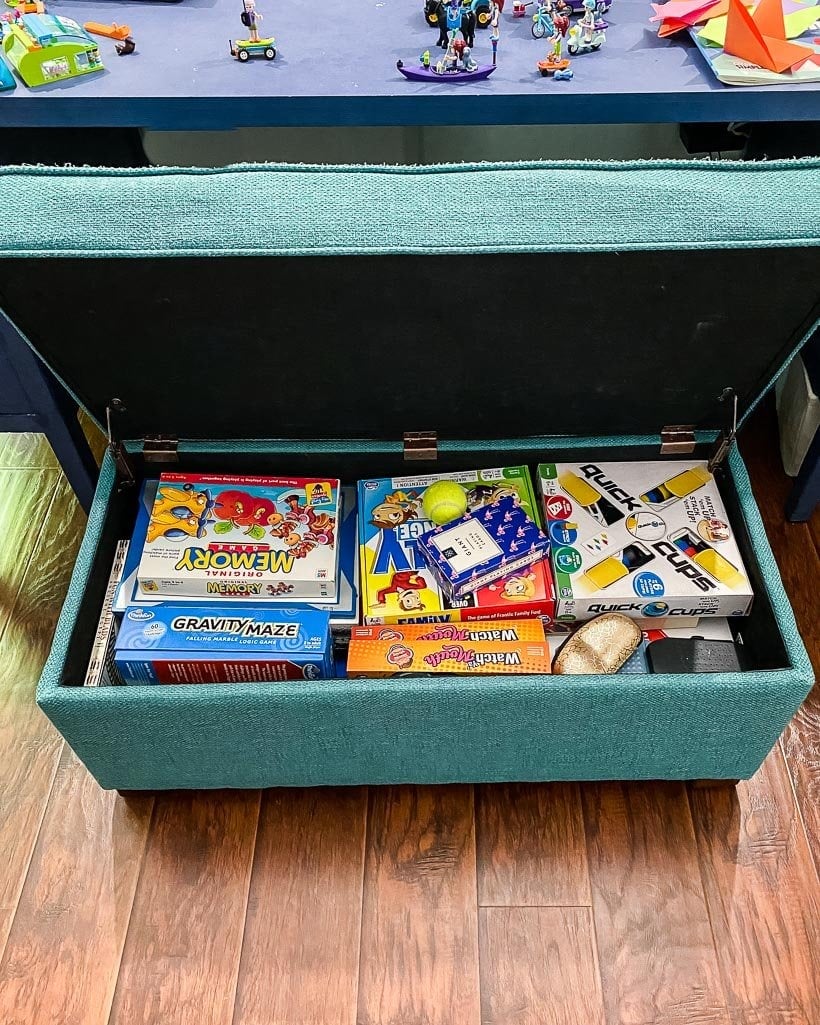
Tips for Maintaining a Clutter-Free Home
Phew. That was a lot of information about how to declutter your home, huh?
To wrap it all up, I will say this. Remember, this is a marathon, not a sprint. ANY progress is a job well done even if it's just 10 minutes a day when you have time. You are not going to magically declutter your entire home in a weekend or even a month (unless you do something like hire a professional organizer or someone else to help you). That is just not realistic for 99% of us.
And please keep this in mind, decluttering is never really “done” even after you've tackled every space in your home. You need to deal with “daily clutter” such as mail, clothes and toys every day. But you WILL get to a point where you can keep your house decluttered with just 10 minutes a day (or an hour a week if you prefer to deal with it weekly). And if you regularly set aside that little bit of time to handle “daily clutter” as it comes in (a family command center helps with this!), you'll avoid ever getting back to the point of feeling overwhelmed by your clutter.
You can also avoid bringing too much into your home moving forward! Before buying anything new, make sure you really need it AND that you know where you will keep it. If you don't know where you will keep it, leave it at the store!
After you feel like you have your clutter under control, then you can turn your attention to getting more organized AND toward decorating your home. And you all know the decorating is my favorite part! I have loads of interior design tips just waiting for you when you are ready!
Other decluttering and organizing posts you may enjoy:
Wondering how I approach transforming rooms and spaces in our home? Check out Designer in a Binder®.
And if you want exclusive content and behind-the-scenes sneak peeks, be sure to subscribe before you head out!

Last Updated on May 20, 2022


